| Summary: | All 75 stations occupied: 66 standard & 9 SCCOOS 20m isobath stations |
| Data Links: | 1210NH CTD Cast Files; Final bottle-corrected CTD csvs, plots, & metadata; |
| Cruise Dates: | 19 October - 05 November 2012 (Fri - Mon) |
| Load Dates: | 16 - 18 October 2012 at MarFac, Pt Loma (Tues - Thurs) |
| Offload Date: | 06 Nov 2012 (Tues) |
| Ship: | SIO RV New Horizon; (CalCOFI NH Layout) |
| Station plan: | 75 Standard (66 CalCOFI + 9 SCCOOS); Predicted Schedule & Station Plan.htm (spreadsheet; .xls) |
| Cruise Instructions: | NOAA-SWFSC Cruise Instructions (pdf) |
| Cruise Map: |
 |
| Contacts: | James Wilkinson, Chief Scientist, SIO-IOD |
| Amy Hays, NMFS (Fisheries Technical Coordinator) |
Please note that the anomalies are based on 50-year harmonics and that these data are direct from the CTD and have not gone through thorough quality control checks. They are presented to give a general impression of current conditions. Final data plots will be published after all data are processed.
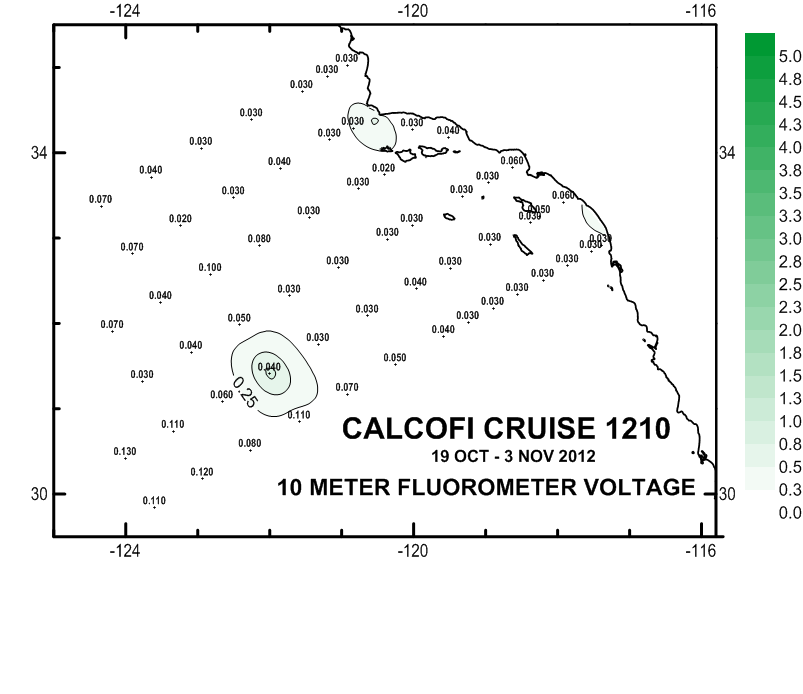 |
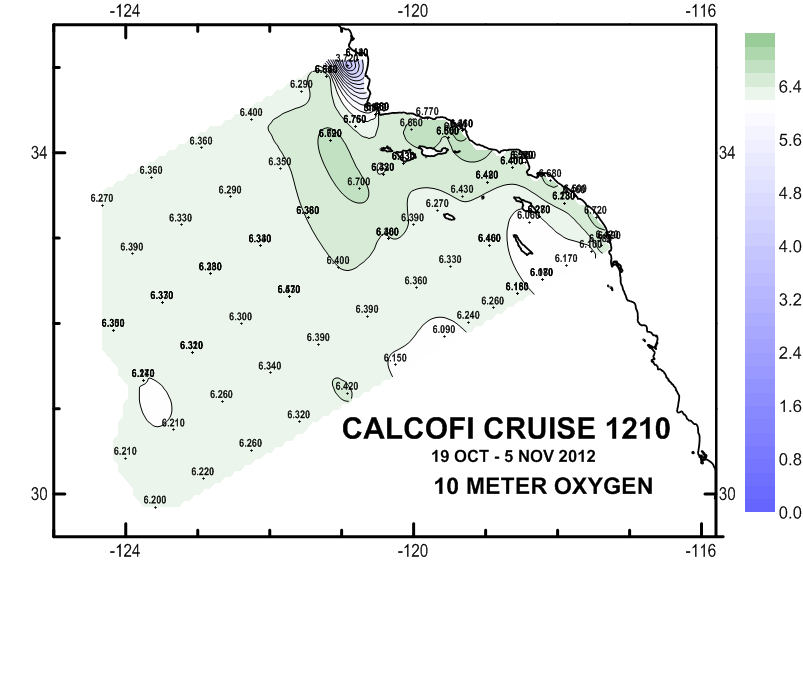 |
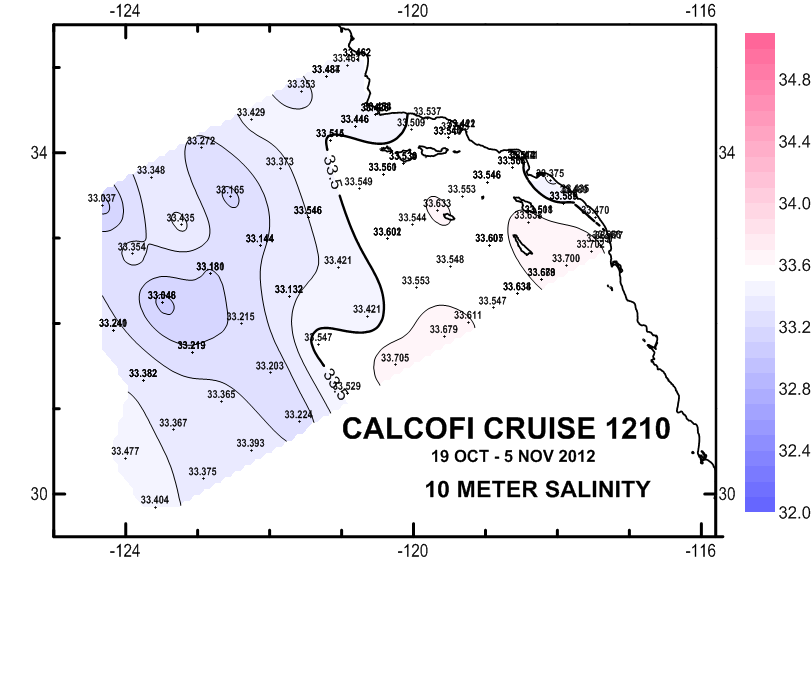 |
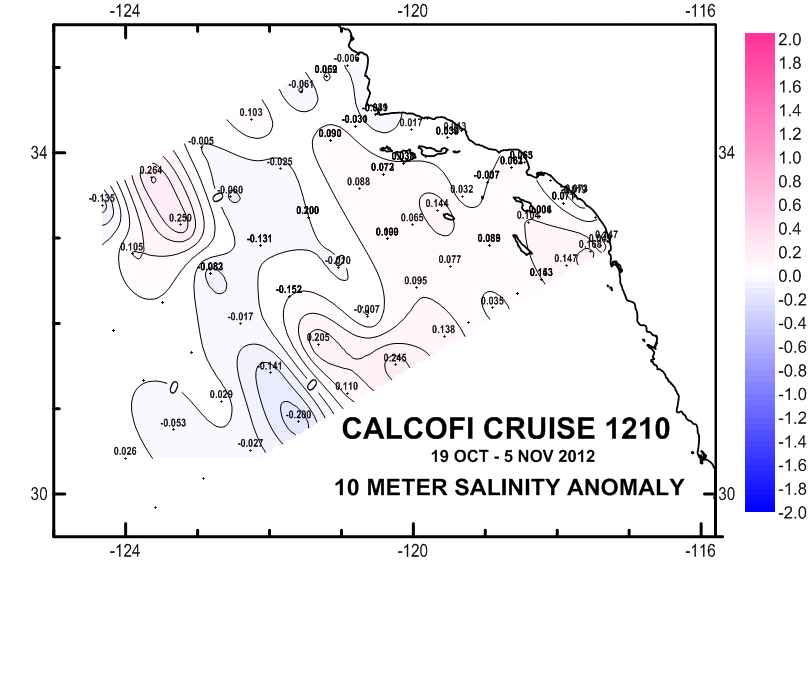 |
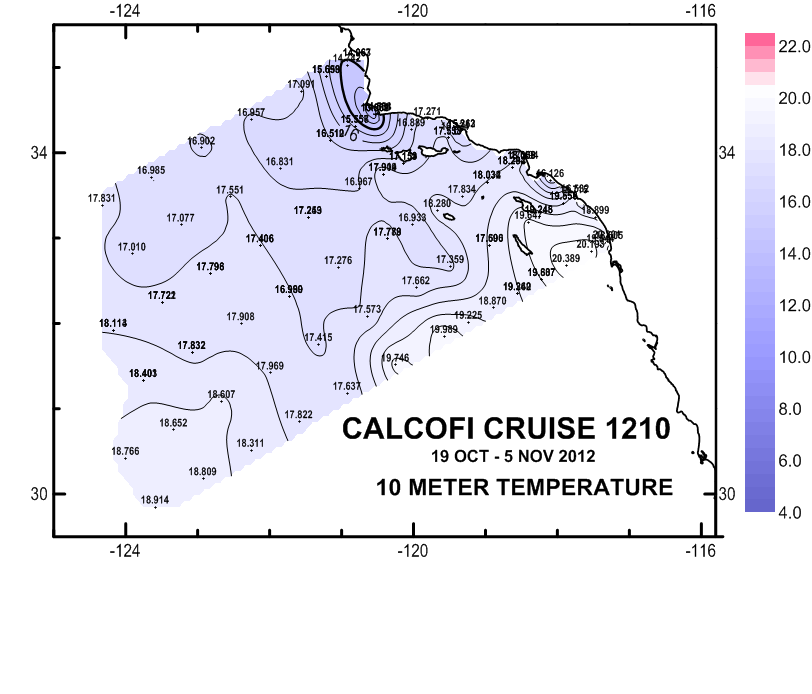 |
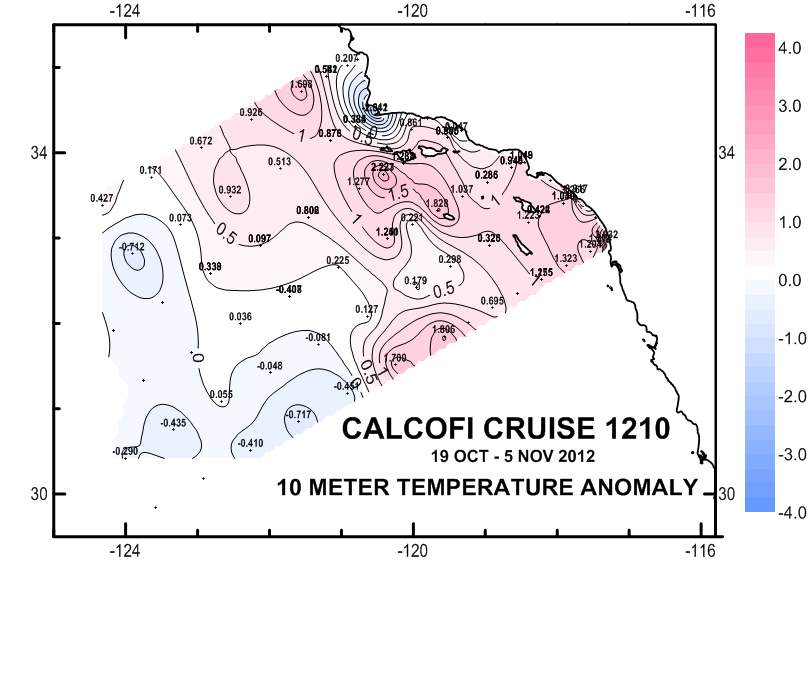 |
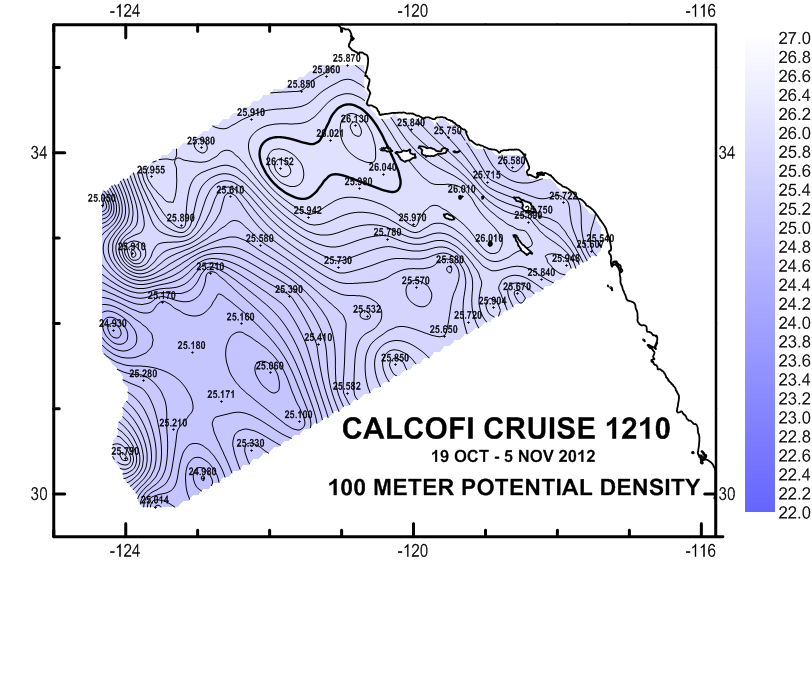 |
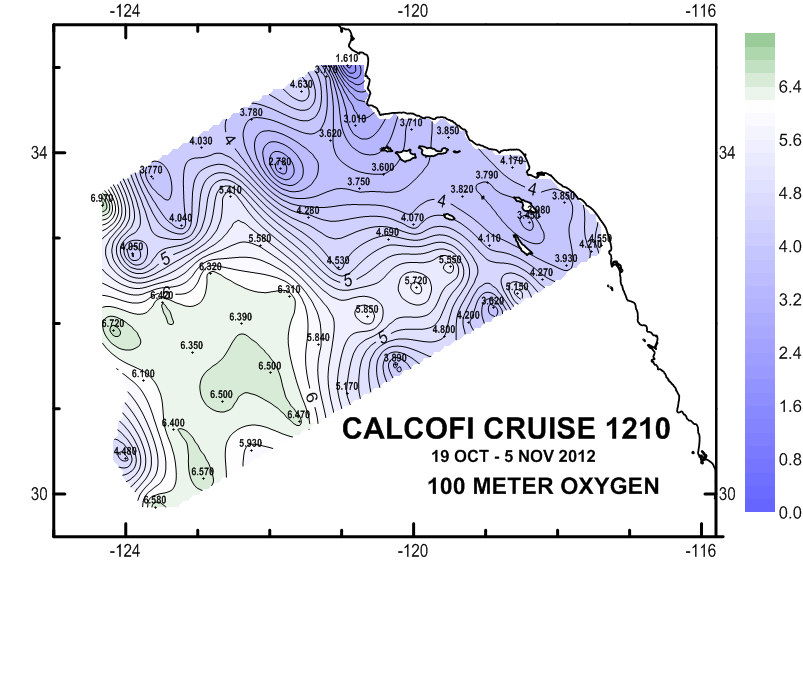 |
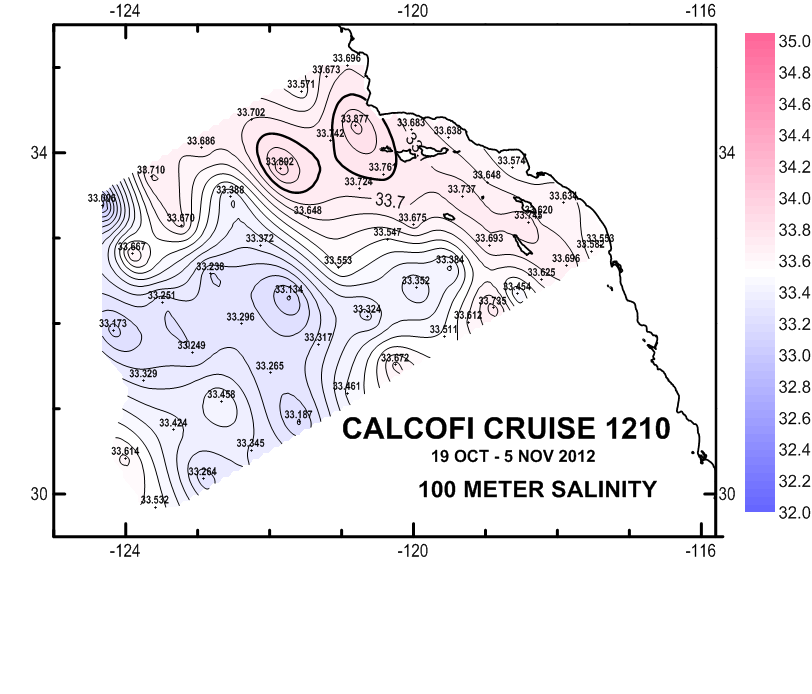 |
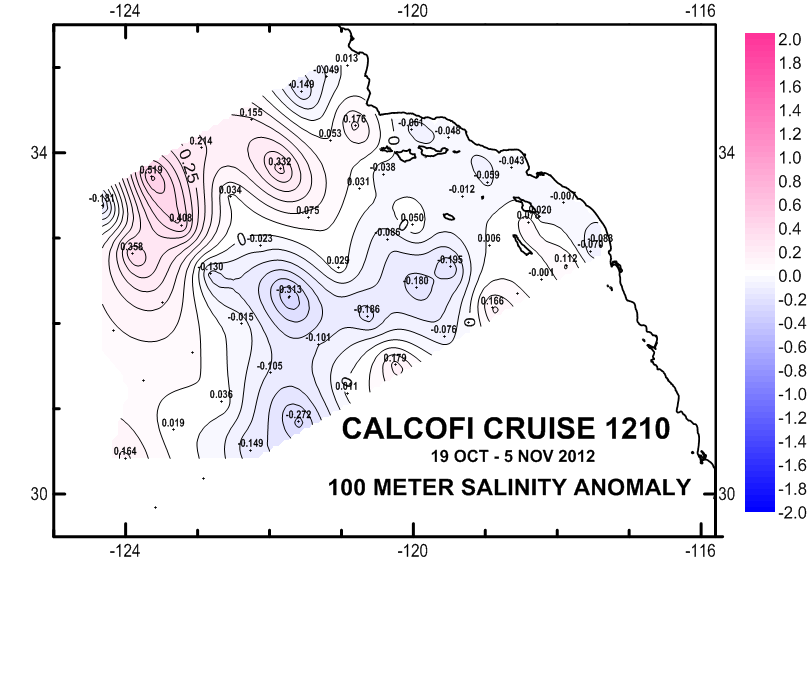 |
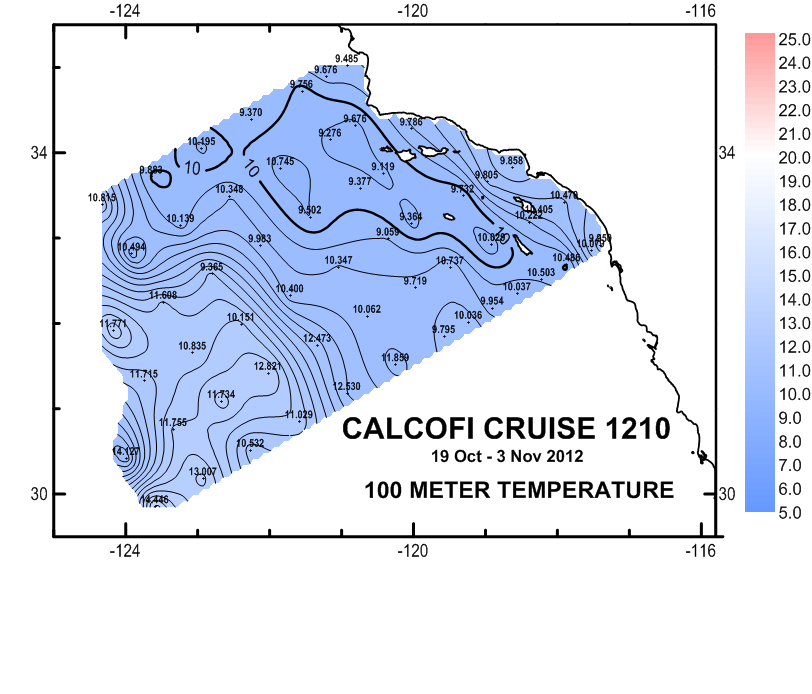 |
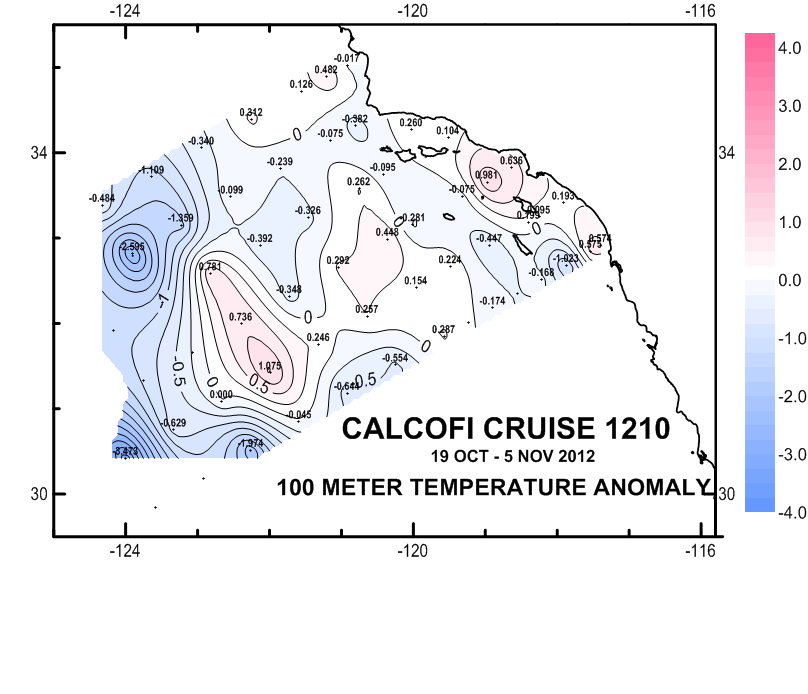 |
| Download 1210 CTD raw cast files zipped | Download 1210 FinalQC CTD + bottle data with data quality codes | ||
| CTD sensor corrections derived by comparing 4 secs of CTD sensor data (prior to bottle closure) to bottle samples | |||
| Dual T, S, & O2 | Primary Sensor | Secondary Sensor | |
| Salinity offset (bottle - CTD salinity; > 350m only; Seabird SBE4) | 0.00010 | 0.00482 | |
|
Oxygen (Seabird SBE43 as Primary; RINKO (voltage 6 & 7) as 2nd O2 on casts 5 - 24, 26, 36 - 52, 62 - 72 Altimeter on voltage 6 on casts 1 - 4, 25, 27 - 35, 53 - 61, 73 - 75 |
y = 0.8858x - 0.0959 R² = 0.9989 |
No RINKO regression available, data were pre-processed | |
| Single sensors | |||
| Nitrate - ISUS 4sec ave voltage vs Bottle Nitrate (Satlantic MBARI-ISUS v2) |
y = 29.289x - 10.384 R² = 0.9868 |
||
|
Fluorometer - Seapoint #3069 used casts 001 - 021 (failed cast 021, 3600m) |
y = 1.3284x + 0.0126 R² = 0.8791 |
y = 8.9123x² + 2.1153x + 0.01 R² = 0.8878 |
|
 |
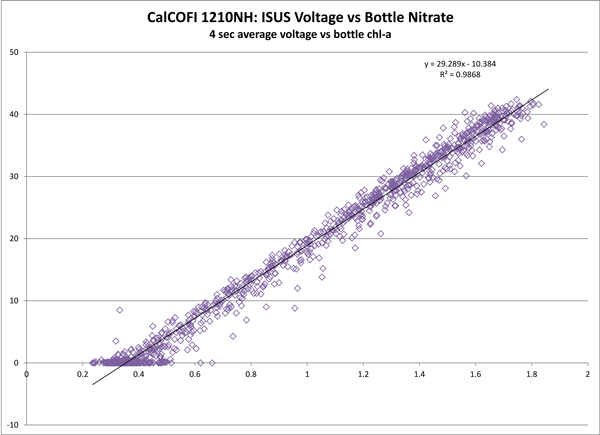 |
||
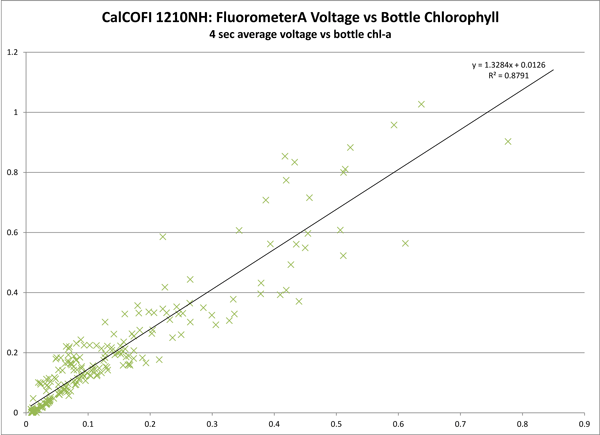 |
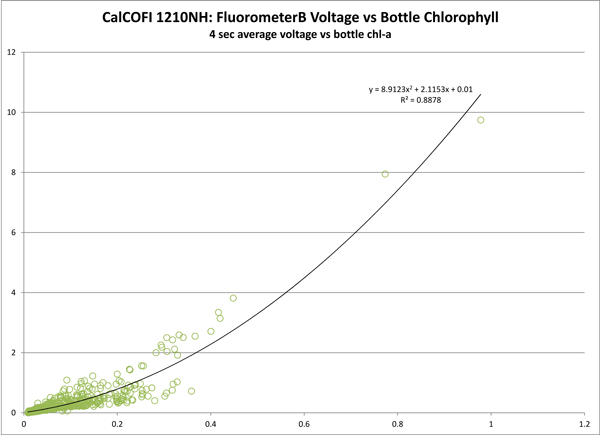 |
||
|
General CTD Notes Casts affected - 004 93.3 28.0; 005 93.3 30.0; 006 93.3 35.0
2017 note on RINKO data: it was discovered during the 2017 reprocessing, that casts 005, 007, & 026 had pressure-to-depth calculation errors in the downcast RINKO data provided by ODF. These data have been corrected in the 'finalQC' CTD.csvs.
08Mar2017 other than the RINKO error mentioned above, the reprocessing adds data-quality code columns and data codes on bad or missing data ("9"), or questionable data ("8"). Data values should not have changed from the previously published final CTD data. But the column number on updated CTD.csvs has changed from 65 to 82.
Cast notes - (unusually) significant issues this cruise with non-confirmation of bottle closures:
2017 Updates - Re-merged the CTD asc files with sta.csvs to generate new CTD.csvs with data quality code columns.
Specific cast notes 2017: Cast 005: The upcast had ISUS sensor drop-outs from 458-437m, these data were edited out of the upcast csv and data coded. Casts 009-012: ISUS battery was not powering the sensor so there are no data; data codes have been added. Cast 037: ISUS signal loss 133-118m on upcast; bad data removed and missing depths data coded.
Cast 044: very slight hiccup in ISUS data at depth in both downcast and upcast files. 502-516m downcast ISUS data
Cast 045: ISUS signal loss 482-437m on upcast; bad data removed and missing depths data coded. Recommend cruise-corrected
Cast 047: mild problem in ISUS data at depth in both downcast and upcast files. 514-515m downcast ISUS data Cast 048: upcast-only ISUS signal loss from 393-378m & 134-119m; bad data removed and missing depths data coded.
Cast 065: data look like they may improve if loopedit was used. SIO-CalCOFI does not typically apply loopedit to Cast 069: downcast ISUS data dropouts between 75-111m; data removed and data codes added.
Cast 073: downcast looks fine but upcast may have had a bio-fouling problem. Upcast salinity, and oxygen data do JRW 03/07/2017 |
|||
On CalCOFI 1210NH, a RINKO optode oxygen sensor was deployed on 51 CTD-Rosette casts. Along with the RINKO sensor, a Seabird SBE43 oxygen sensor functioned as the primary oxygen sensor for the cruise. There were 75 stations in total - on 24, an altimeter was needed so the RINKO sensor was disconnected & dummy plugged. On casts 005 - 024, 026, 036 - 052, 061 - 067, the RINKO was mounted vertically; on casts 068 - 072, the RINKO was mounted horizontally.
RINKO oxygen values were very close to Winkler titration oxygen sample values. Comparison of RINKO oxygen data to processed non-bottle corrected SBE43 oxygen data were significantly different (~-0.6 ml/L). Bottle-corrected SBE43 oxygen values, which SIO-CalCOFI considered the best data, did not significantly differ from either RINKO or bottle values (>0.1ml/L). Based on these very preliminary comparisons, if bottle oxygen calibration samples are not available, the RINKO optode oxygen sensor would provide significantly better data than the SBE43.
| Plot file containing all 51 oxygen plot comparisons: 1210RINKOvsSBE43plots.zip | |
| RINKO Compared to processed SBE43, not bottle-corrected | RINKO Compared to processed SBE43 & SBE43 bottle-corrected |
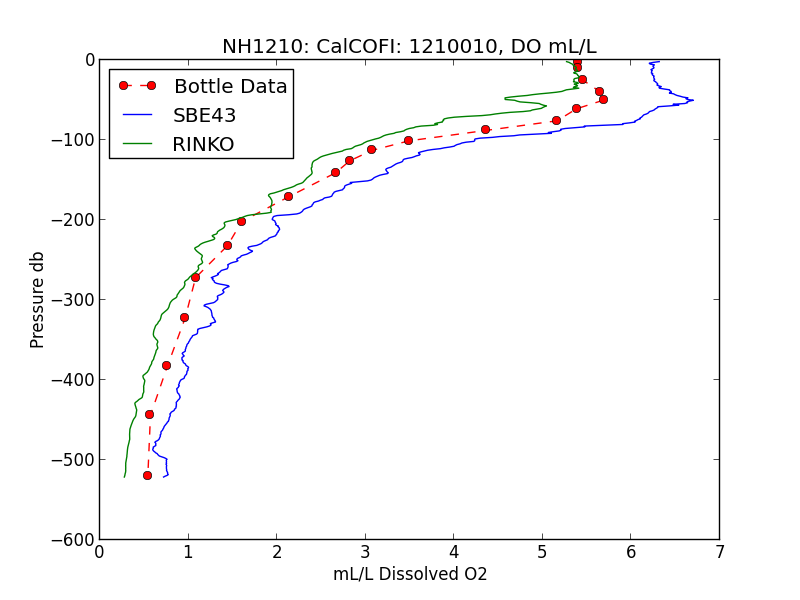 |
.png) |
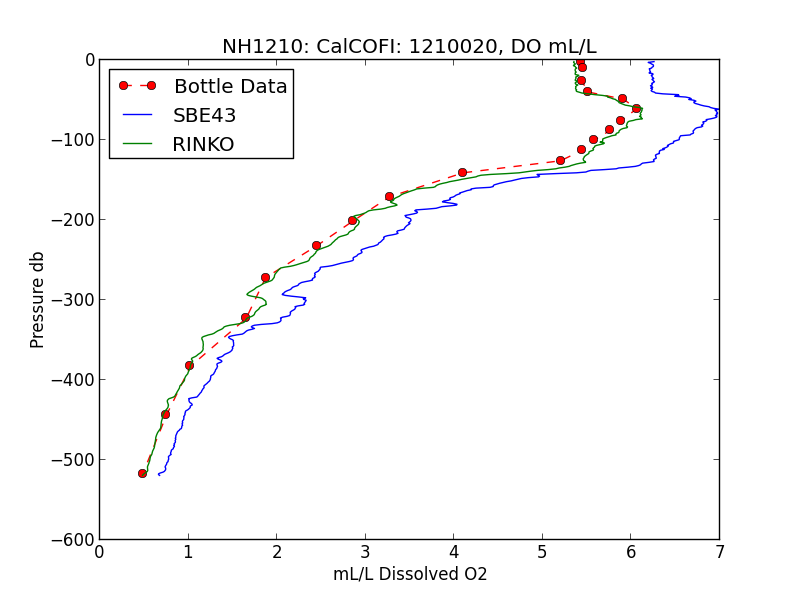 |
.png) |
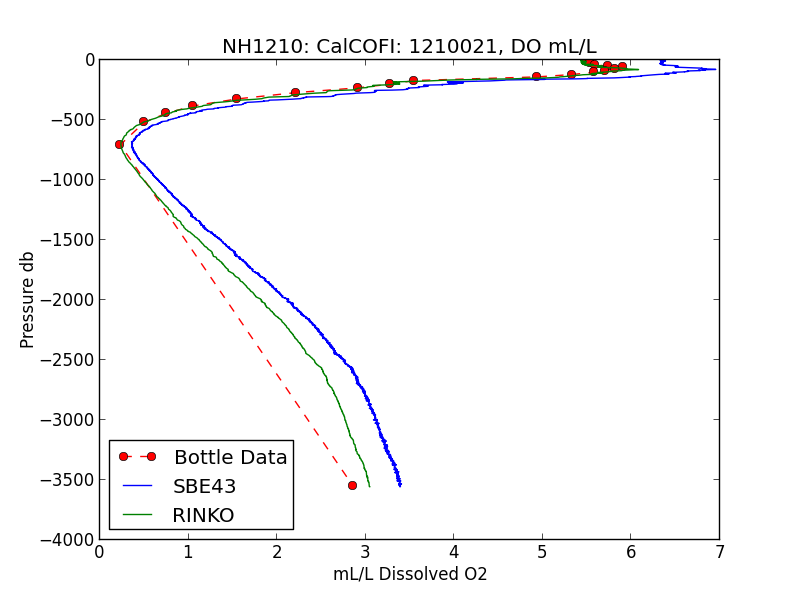 |
.png) |
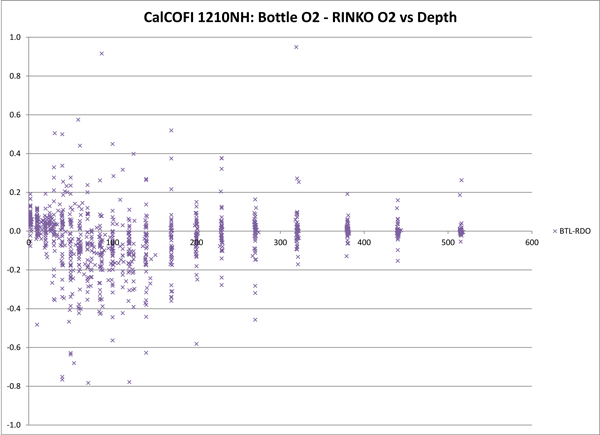 |
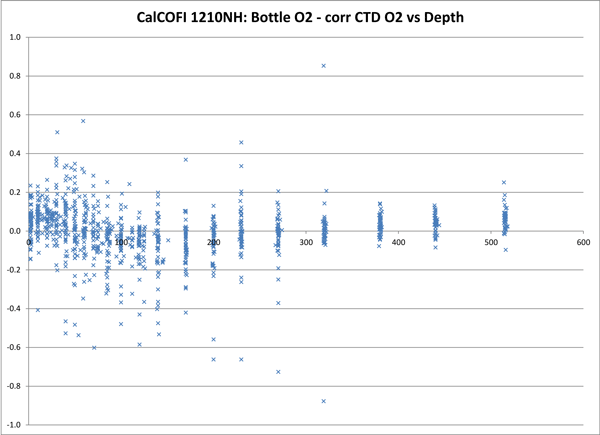 |
| Average diff = 0.000, StDev = 0.1541 | Average diff = -0.001, StDev = 0.1379 |
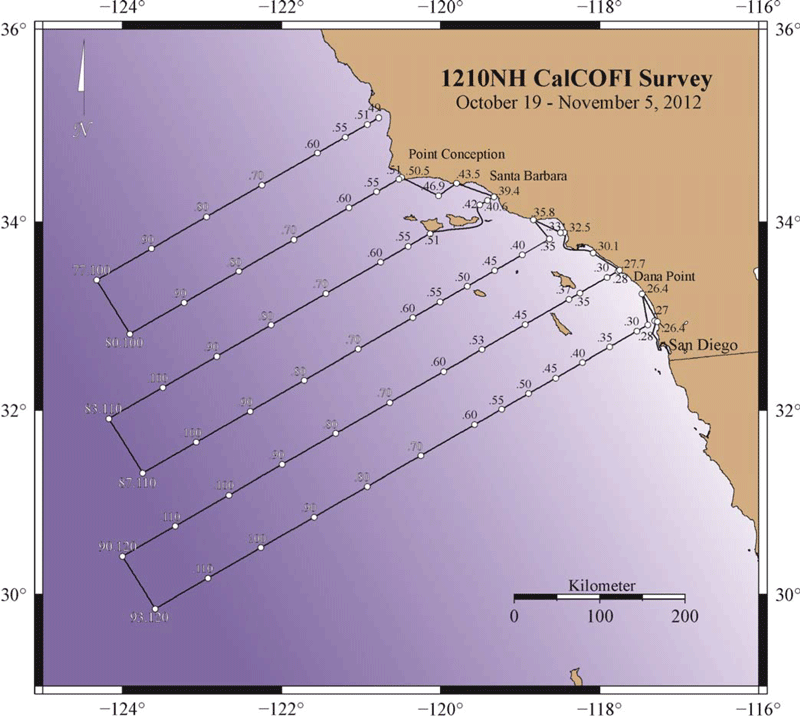 VESSEL: R/V New Horizon (SIO) Cruise 1210-NH.
VESSEL: R/V New Horizon (SIO) Cruise 1210-NH.
CRUISE DATES: October 19 – November 5, 2012.
PROJECT: CalCOFI Survey, Fisheries Resources Division.
ITINERARY: Depart San Diego, California at 0800 on October 19, 2012.
Calibration of the Simrad EK60 echosounders will be performed at the beginning of the cruise (requiring 4 - 6 hours). The ship will
anchor in San Diego Bay, San Diego, and calibrate. After small boat transfer of calibration team, the ship will proceed to the
first CalCOFI station 93.3/26.7 (position 32° 57.4'N/117° 18.3'W) and begin a standard CalCOFI pattern (see attached cruise track).
The vessel will return to San Diego, California on November 5, 2012.
OBJECTIVES:
- To continue an ongoing assessment of pelagic fish stocks between Morro Bay and La Jolla, California.
- To monitor environmental conditions within the CalCOFI survey area.
- To conduct continuous underway sampling of surface waters. Temperature, salinity and chlorophyll will be automatically logged by computer with the output from the GPS navigational unit.
- To record current profiles throughout the duration of the cruise with the Acoustic Doppler Current Profiler.
- To measure optical profiles within the California bight. The optical profile measurements will include pigment concentration and particle absorption.
- To record continuous acoustic targets obtained with the Simrad EK-60 scientific sounder.
PROCEDURES:
-
Each standard CalCOFI station will include the following:
- A CTD/Rosette consisting of 24 10-liter hydrographic bottles will be lowered to 500 meters (depth permitting) to measure physical parameters and collect water at discrete depths for analysis of: oxygen concentration, salinity, nutrients, chlorophylls and phytoplankton.
- A CalBOBL (CalCOFI Bongo) standard oblique plankton tow with 300 meters of wire out, depth permitting, using paired 505 µm mesh nets with 71 cm diameter openings. A self-contained LOPC (Laser Optical Particle Counter) will be mounted in the port side opening during each tow. The technical requirements for this tow are: Descent rate of 50 meters per minute, ascent rate of 20 meters per minute. All tows with ascending wire angles lower than 38° or higher than 51° in the final 100 meters of wire will be repeated. Additionally, a 45° wire angle should be closely maintained during the ascent and descent of the net frame.
- A Manta net (surface) tow, using a 505 µm mesh net on a frame with a mouth area of 0.1333 m².
- Weather observations.
- A Pairovet (vertical) plankton tow will be taken at all stations inshore of, and including station 70. The Pairovet net will be fished from 70 meters to the surface (depth permitting) using paired 25 cm diameter 150 µm mesh nets. The technical requirements for Pairovet tows are: Descent rate of 70 meters per minute, ascent rate of 70 meters per minute. All tows with wire angles exceeding 15° during the ascent will be repeated.
- A PRPOOS (Planktonic Rate Processes in Oligotrophic Ocean Systems) net tow will be taken at all stations on line 90.0 and 80.0 as well as stations out to and including station 70.0 on lines 86.7 and 83.3. These stations are occupied as part of the LTER(Long Term Ecological Reserve) project. The mesh of the PRPOOS net is 202 µm and the tow is a vertical cast up from 210 meters.
- At about 1100 hours on each day of the cruise a primary productivity CTD cast consisting of six 10-liter hydrographic bottles will be carried out. The cast arrangement will be determined by a Secchi disc observation. The purpose of the cast is to collect water from 6 discrete depths for daily in situ productivity experiments. Measurements of extracted chlorophyll and phaeophytin will be obtained with a fluorometer. Primary production to be measured as C14 uptake in a 6 hour in situ incubation. Nutrients will be measured with an auto-analyzer. All radioisotope work areas will be given a wipe test before the departure of the SIO technical staff.
- A light meter(secchi) will be used to measure the light intensity in the euphotic zone once a day with the primary productivity cast.
- During transit between stations, a bird observer and three mammal observers will be recording location and species of various sea birds and marine mammals.
- During transit between most daylight stations, an acoustic hydrophone array will be towed off the stern with a cable/winch to record sounds from marine mammals. Upon approaching a station, a sonobuoy will be deployed one nautical mile prior to stopping for station work.
- A MOHT(Oozeki) pelagic trawl will be deployed on approximately 16 night/day time CalCOFI stations within the standard CalCOFI grid(lines 76.7 to 93.3). This will encompass both adaptive and non-adaptive sampling in conjunction with the EK-60. The Oozeki is a fixedframe trawl with a 5.5 m² mouth opening that can be towed at speeds up to 4-5 knots. It is designed to capture a variety of organisms including krill, late larval and juvenile fishes, and micronekton. The Oozeki data will be used to ground truth the EK-60 acoustic data as well as collect samples of juvenile fishes for the study of sardine recruitment processes.
EQUIPMENT:
1. Supplied by scientific party:
- 37% Formalin (SWFSC)
- Sodium borate (SWFSC)
- 30 cc and 50 cc syringes (SWFSC)
- Canulas (SWFSC)
- Pint, quart and gallon jars (SWFSC)
- Inside and outside labels (SWFSC)
- CalCOFI net tow data sheets (SWFSC)
- 71 cm CalCOFI Bongo frames (SWFSC)
- 71 cm CalCOFI 505 µm mesh Bongo nets (SWFSC)
- CalCOFI 150 µm calvet nets and codends (SWFSC)
- CalCOFI pairovet frames (SWFSC)
- 333 µm mesh codends (SWFSC)
- Inclinometer for bongo tows (SWFSC)
- Digital flowmeters (SWFSC)
- 75 lb Bongo weights (SWFSC)
- 170 lb hydro weight (SWFSC)
- CalCOFI Manta net frames (SWFSC)
- 60 cm CalCOFI 505 µm mesh Manta nets (SWFSC)
- Standard CalCOFI tool boxes (SWFSC)
- Bucket thermometers and holders (SIO)
- Hand held inclinometer (SIO)
- Oxygen titration rig with reagents (SIO)
- Oxygen flasks (SIO)
- Guildline Portasal (SIO)
- Salinity bottles (SIO)
- Standard sea water (SIO)
- Data sheets for scheduled hydrographic work (SIO)
- Weather observation sheets (SIO)
- CTD and rosette (SIO)
- 10 liter hydrographic bottles (SIO)
- Isotope van (SIO)
- LTER van (SIO)
2. Supplied by R/V New Horizon:
- Hydro winch with ¼" cable for standard Bongo, Pairovet and Manta tows
- Oceanographic winch w/.322" conductive cable
- J-frame w/blocks to accommodate .322" conductive cable and ¼” mechanical cable
- A-frame w/block to accommodate Oozeki .580" trawl wire
- Constant temperature in main lab set at 22°C ±1°C (71.5°F ±2°F)
- Winch monitoring system
- 12 kHz Knudsen precision depth recorder
- Acoustic Doppler Current Profiler
MISCELLANEOUS:
- At the completion of the cruise an inspection will be made of scientific working and berthing spaces by the Master or his designated representative. The scientific party is responsible for the condition and cleanliness of spaces assigned to the scientific party.
- The Cruise Leader will hold a pre-cruise meeting aboard the vessel before departure.
- All dates and times recorded will be in Pacific Standard Time.
Date: 2 October 2012
Prepared by: Amy E. Hays
Approved by:
Francisco Werner, Ph.D.
Science & Research Director
Southwest Fisheries Science Center

